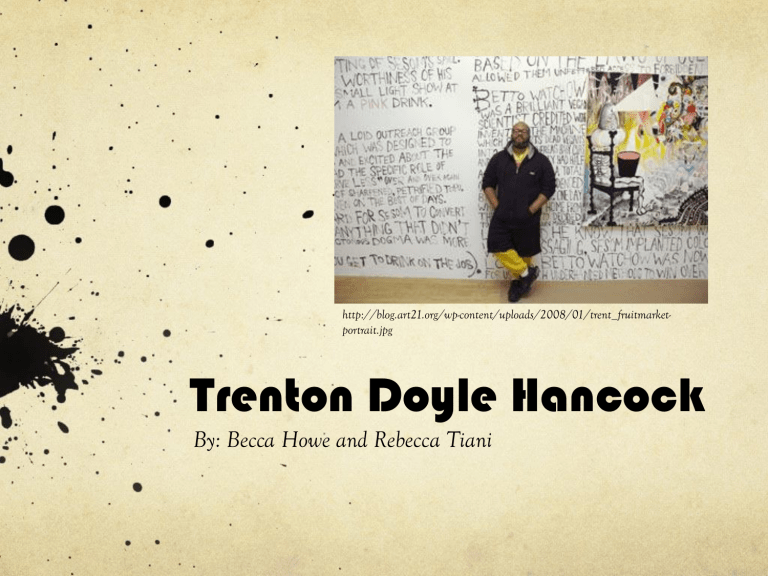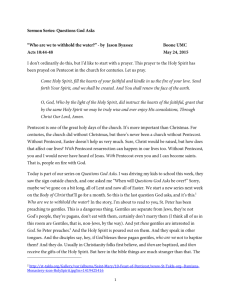Artist Presentation

http://blog.art21.org/wp-content/uploads/2008/01/trent_fruitmarketportrait.jpg
Trenton Doyle Hancock
By: Becca Howe and Rebecca Tiani
Biographical Information
Early Life: was born in Oklahoma City, 1974
Grew up in an African American religious family and was raised in the southern Baptist church
Started off wanting to be a comic book artist, but as he grew older, he became interested in other forms of art
(he never lost his passion for narration though) http://houstonfineartfair.com/files/2012/07/
Trent.jpg
Education
Associate of Science, Paris Junior College, Paris, Texas.
BFA from Texas A&M University, Commerce.
MFA from Tyler School of Art at Temple University,
Philadelphia, Pennsylvania http://teach4amerika.org/wpcontent/uploads/2011/01/TylerSchoolofArt-
150x150.jpg
Shows and Awards
Has participated in over 25 solo shows since 1997.
Participated in 75 different group shows since
1995.
Featured in both the 2000 and the 2002 Whitney
Biennial Exhibitions, which is a prestigious and highly regarded show. He was one of the youngest people to ever be featured in this show, when he was just 25 years old.
Has been granted a whole slew of awards and has been featured in many museums, including the
Contemporary Arts Museum, Houston; and the
Modern Art Museum of Fort Worth.
Was the 2002 Core Artist in Residence as Glassell
School of Art of the Museum of Fine Arts,
Houston. http://ecx.imagesamazon.com/images/I/41Z21MDXKCL._SL500_AA300_.jpg
http://whitney.org/www/2002biennial/images/wb2002screen.gif
Family Influences
Grew up very close to his family.
Spent a lot of time with his mother and aunts, so work in inspired by them, especially his mother.
Carries “echoes” of his family with him wherever he goes- He brings items of his family members with him so that he can remain close to them.
Is obsessed with recreating his childhood, its importance, and its stories so he has a passion for collecting old toys, and he finds much inspiration when searching for these toys.
Artistic Influences
http://artistquoteoftheday.files.wordpress
.com/2008/01/max.jpg
Hancock grew up wanting to make comics.
He was always the kid in grade school who sat in the back of the room and just drew pictures.
He strayed away from comics as he got older, but he still uses the element of narration in his current works.
His works have been compared to
Hieronymus Bosch, Salvador Dali, and
William Blake. Though Hancock admits that these men were all influences, he really cites
Max Ernst as an influence because of how bizarre Ernst’s work is.
Draws a lot of influence from thrift store paintings that were made by amateurs.
Also draws influence from the style of
Abstract Expressionism.
Religious Influences
Step-father was a pastor and many of his family members were pastors.
Loved the stories of the bible and he takes those stories with him so that he can make reference to them.
Reworks the stories of the bible that he learned from his family and church community.
Work became obsessed with religion and mythology after he finished grad school.
Process and Medium Types
Typically works in the mediums of printmaking, drawing, painting, and collaged-felt paintings.
Has even helped create a ballet based on his work with Ballet Austin in April 2008 (Cult of Color: Call to Color.)
Is very much about experimentation- He likes the risk of trying new things.
Only about 10% of the time he knows how he wants a work of art to look from the beginning. The rest of the time he had no interest in how it will turn out, he just wants to make discoveries along the way.
Presents his subjects in a panel-by-panel narrative style.
Draws his characters over and over before putting them into a work to test whether they can stand the test of time.
http://www.balletaustin.org/imag es/cultofcolor/cult-of-color.jpg
http://t1.gstatic.com/images?q=tbn:
ANd9GcSu6apoztLKFiOD2ytyjVXI dR4B4MIXvuUJC1xf01SID721p6fl1f1hKyfDw
The Mounds
http://cdn1.lostateminor.com/wpcontent/uploads/2009/04/trenton-doyle-hancock.jpg
The Mounds are the main protagonists of his works.
They are half human-half plant creatures who came to life 50,000 years ago when an ape man masturbated into a field of flowers.
Works to chronicle the life, death, afterlife, and even dream-states of these creatures.
The story of these creatures comes to him as visions. Whenever he has one of these visions, he asks himself a lot of questions to get to the essence of what these creatures are.
Questioning is a huge part of his work.
The Mounds represent things that are primarily good in life, and the process of taking in good things.
The Vegans
The Vegans are the enemies of the
Mounds. They are evil tofu-munching ape-men mutants who want aim to destroy the Mounds.
The Vegans are all about pushing away all good things in life and denying things because they are untrustworthy.
They are based on Hancock’s experience with staunch vegans who he met in grad school.
A stand-in for people who push their morality on others. Instead of using religion or Christianity, he elevates veganism to ridiculous proportions.
http://www.nashvillescene.com/binary/24b9/1329869257hancock_vegans.jpg
http://frontrow.dmagazine.com/wpcontent/uploads/2010/09/torpedoboy-crop.jpg
The Trinity
Has three characters who show up in his work who sort of act as a hold trinity.
Loid- black and white. Meant to be a sort of energy. Is more stern and stoic.
Painter- colorful. A spirit energy who acts as a mother type.
Torpedo- The son of Painter and Loid. He is a superhero, but also Hancock’s alter-ego.
Deeper Themes and Meanings
His main theme is the examination of the relationship between the Vegans and the Mounds.
Work is highly allegorical. He makes reference to the themes of the bible, but also chronicles struggles and such.
Allegory has been interpreted as intellect vs. intuition, nature vs. nurture, human race vs. the planet, black vs. white, and other themes.
He tried to tell himself that his work was primarily about race and racial struggles, but he realizes now that his work doesn’t have to mean that. He leaves the theme for the viewer to decide.
References
www.pbs.org/art21/artists/trenton-doyle-hancock www.jamescohan.com/artists/trenton-doyle-hancock http://www.youtube.com/watch?v=oAC_7Ceo3Ok www.icaphilia.org/exhibitions/hancock.php
www.kspacecontemporary.org/opportunities/cultofcol or_hancockweb.pdf







